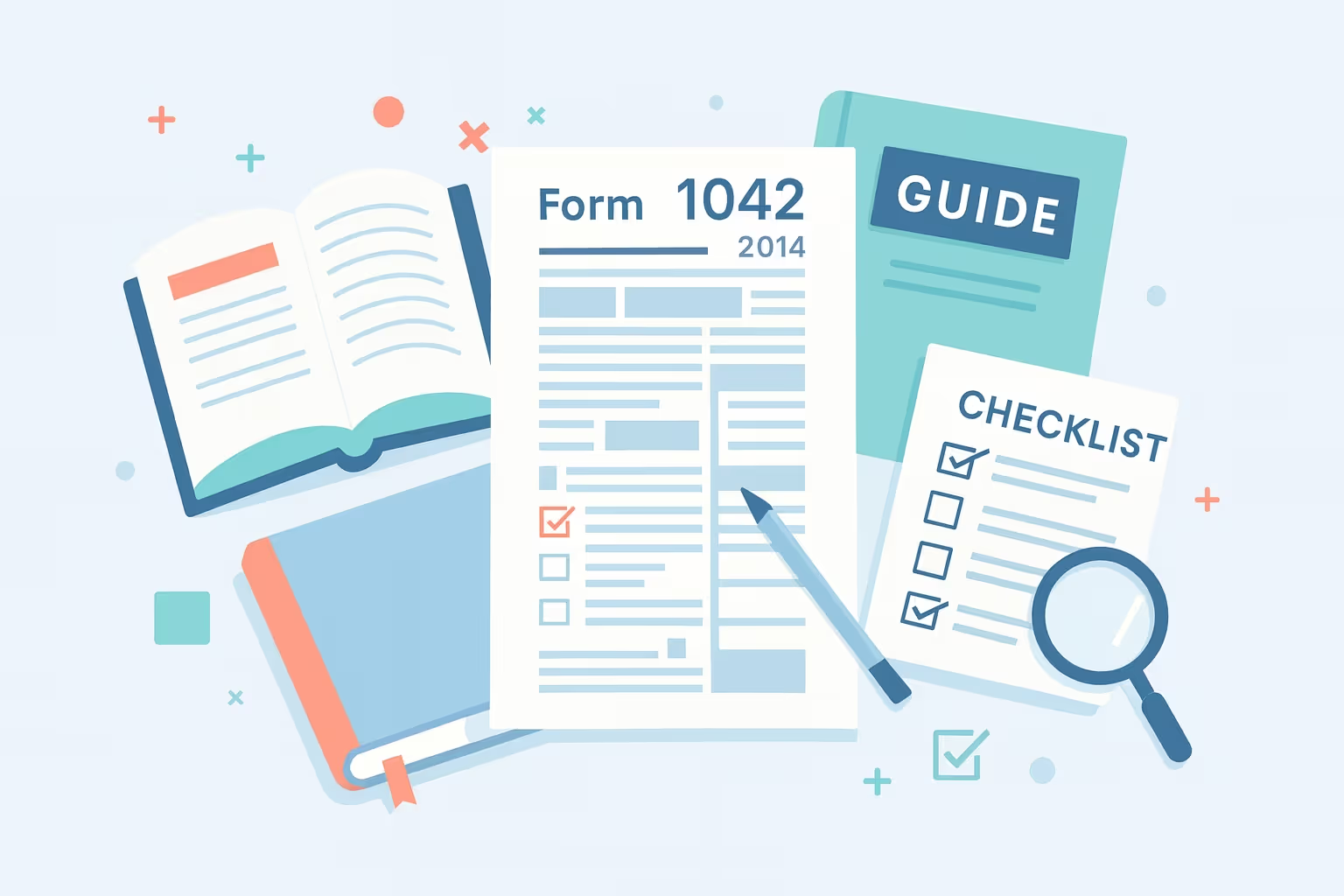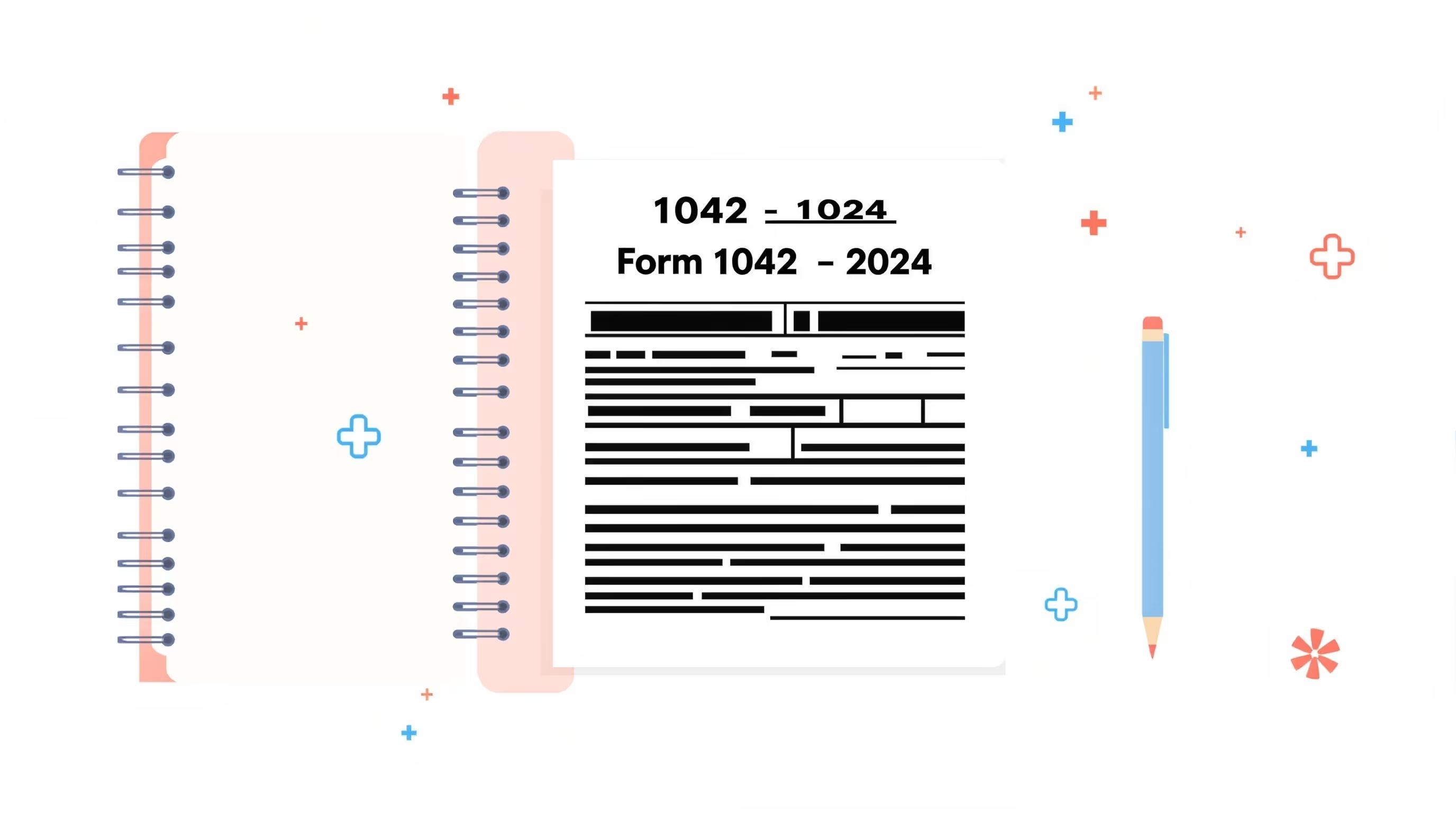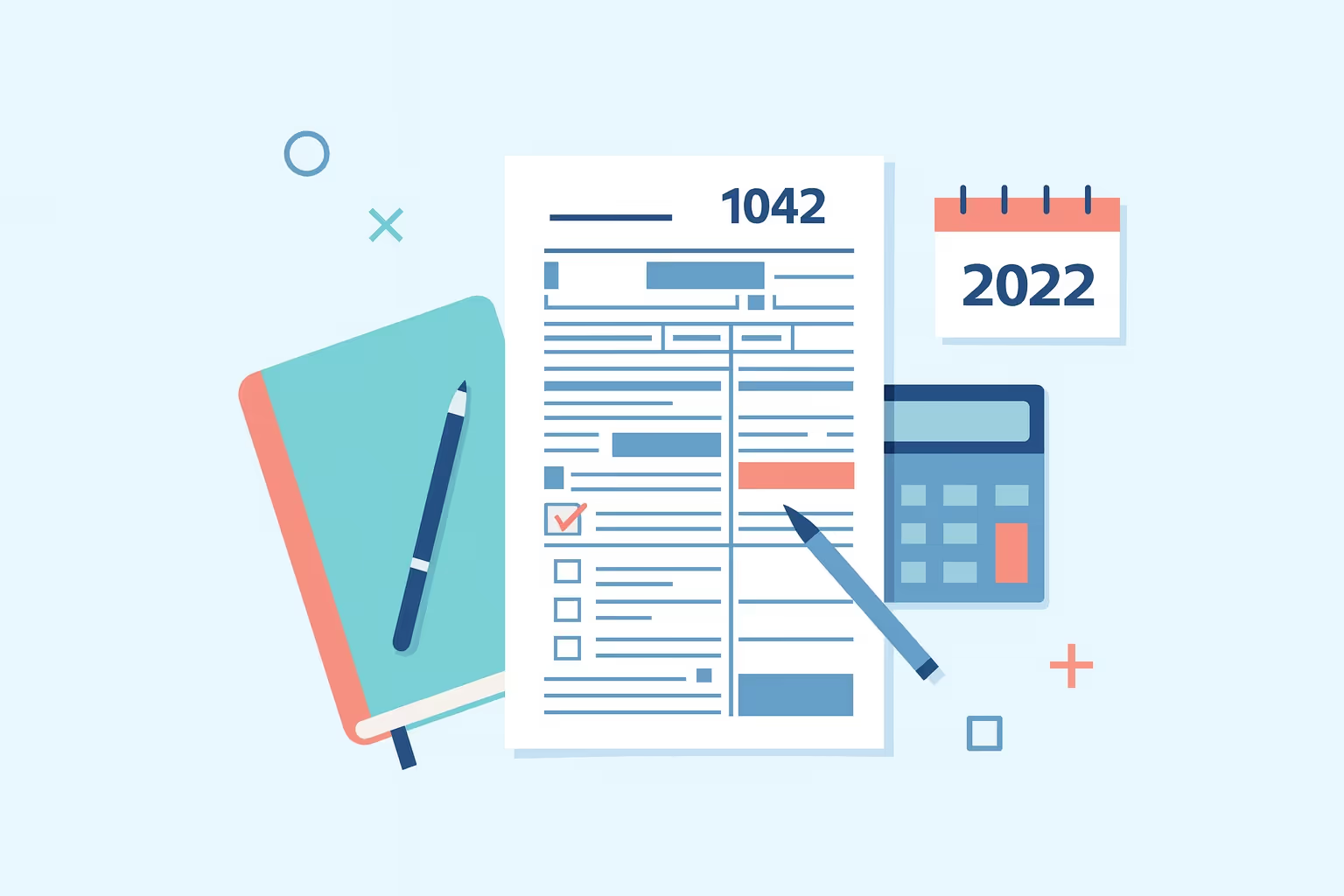Comprehensive Guide to Form 1042 2014 Instructions

Form 1042 is the annual withholding tax return used by withholding agents to report U.S. source income paid to foreign persons during a specific tax year. For the 2014 filing period, this income tax return was due on March 16, 2015, covering all payments made in the 2014 calendar year. The form ensures that amounts paid to nonresident aliens, foreign corporations, foreign partnerships, foreign trusts, and foreign estates are correctly reported and that tax withheld is accurately documented. Compliance with the instructions provided by the Internal Revenue Service is essential to avoid penalties and interest.
The role of the withholding agent is central to this process. Any individual, corporation, or other entity that has control or custody over source income is responsible for ensuring that federal tax liability is accurately calculated and reported. This includes situations involving dividends, interest, royalties, capital gains, or other forms of fixed or determinable annual or periodical (FDAP) income. Withholding agents must also reconcile tax withheld with supporting forms, such as Form 1042-S, and maintain proper records as required under the Internal Revenue Code.
Understanding these responsibilities is critical, particularly for first-time filers or businesses engaged in cross-border transactions. Filing Form 1042 requires careful attention to taxable income, gross income, deductions, and applicable provisions under U.S. taxation rules. By closely following the IRS guidelines, withholding agents can ensure that both their own obligations and those of foreign entities and beneficial owners are met, thereby safeguarding compliance in the reporting and payment of federal taxes.
What’s New for 2014 (FATCA Updates)
The 2014 version of Form 1042 introduced significant changes due to the Foreign Account Tax Compliance Act (FATCA). This legislation, added under Chapter 4 of the Internal Revenue Code, expanded reporting rules for withholding agents handling U.S. source income and certain cross-border transactions. The updates reflect the Internal Revenue Service's effort to improve compliance and clarify how tax liability is calculated for both Chapter 3 and Chapter 4 purposes.
Key FATCA-related updates included the following:
- New reporting lines were added to enable withholding agents to separately track federal tax liability under Chapters 3 and 4.
- Updated status codes were created to distinguish between obligations under traditional withholding rules and FATCA provisions.
- Reconciliation requirements were expanded to ensure that gross income and amounts paid to foreign persons matched what was reported on all related Forms 1042-S.
- A single income tax return, Form 1042, now serves to report both withholding tax on FDAP income and FATCA withholding on withholdable payments.
Another significant change in 2014 was the expansion of electronic filing requirements. Financial institutions and any withholding agent filing 250 or more Forms 1042-S were required to submit Form 1042 electronically. The Internal Revenue Service also clarified that submitting both paper and electronic copies, known as duplicate filing, may result in penalty notices. These changes emphasized the importance of accuracy, efficiency, and proper handling of federal tax obligations during the 2014 tax year.
Step-by-Step Filing Instructions
Filing Form 1042 involves multiple steps, and withholding agents must pay close attention to details to ensure compliance with IRS requirements. The Internal Revenue Service expects that all amounts reported match supporting documents and that the annual withholding tax return reflects the correct federal tax liability.
Pre-Filing Checklist
Before completing Form 1042, withholding agents should take the following actions:
- Gather all Forms 1042-S issued during the tax year to reconcile gross income, amounts paid, and tax withheld. These forms serve as the foundation for the information reported on the annual return.
- Confirm that a valid employer identification number, also known as a taxpayer identification number, has been obtained. Without this number, the Internal Revenue Service cannot process the income tax return.
- Determine the correct Chapter 3 and Chapter 4 status codes that apply to the withholding agent and foreign persons receiving income. These codes ensure accurate reporting under the Internal Revenue Code.
- Review deposit records to verify that all federal tax payments were made through the Electronic Federal Tax Payment System and that deadlines were met.
Completing the Form
- Enter the withholding agent’s legal name, address, and taxpayer identification number, which is exactly as registered with the Internal Revenue Service.
- Report federal tax liability for each month of the calendar year in Section 1. This section provides the IRS with a clear record of when the tax became due.
- Provide information on gross income, taxable income, deductions, and amounts subject to withholding. This step ensures that the correct tax withheld is calculated and reported.
- Record the full amount of deposits made and reconcile these figures with the tax liability reported.
Reconciling With Forms 1042-S
All totals entered on Form 1042 must match the combined totals of Forms 1042-S. If discrepancies occur, the IRS may issue a notice, adjust the liability, or impose penalties. Careful reconciliation helps withholding agents demonstrate compliance.
Final Review Checklist
- Confirm that every required field has been completed and that no sections are left blank.
- Double-check all calculations to ensure that deductions, credits, and applicable provisions are reported accurately.
- Make sure the form is signed and dated by an authorized individual. Unsigned returns are considered incomplete.
- Retain a copy of the completed return and all supporting documents for recordkeeping purposes. These records may be needed during an IRS examination.
Filing Options: Electronic vs Paper
Form 1042 can be filed electronically or by paper, but specific withholding agents are required to file electronically. For the 2014 tax year, the filing deadline was March 16, 2015, and all forms had to be submitted by this date to avoid late-filing penalties.
Electronic Filing Requirements
- Financial institutions were required to file Form 1042 electronically, regardless of the number of forms submitted. This rule ensured consistency and compliance with IRS systems.
- Any withholding agent that filed 250 or more Forms 1042-S also had to submit Form 1042 electronically. This requirement helped the IRS manage large data volumes more efficiently.
- Withholding agents were cautioned not to submit both electronic and paper versions of the form, as duplicate filings could result in penalty notices or processing delays.
Electronic Filing Process
- Withholding agents first needed to register with an approved IRS e-file provider to gain authorization to submit electronically.
- Once registered, they had to prepare the income tax return data according to IRS specifications, ensuring accuracy in all amounts reported.
- After transmitting the return, withholding agents were required to keep the confirmation notice provided by the IRS as proof of successful filing.
Paper Filing Process
- Withholding agents not subject to mandatory electronic filing could mail Form 1042 to the Ogden Service Center. The IRS provided a specific address in the instructions to ensure timely delivery.
- It was essential that withholding agents used the correct address, as mailing to the wrong location could cause processing delays and increase the risk of late penalties.
Extension of Time to File
- A withholding agent who needed more time to file Form 1042 could submit Form 7004, Application for Automatic Extension of Time to File Certain Business Income Tax, Information, and Other Returns.
- The extension granted additional time to submit the form, but did not extend the time to pay federal tax owed. Taxes had to be paid by the original deadline to avoid penalties.
Payment and Deposit Requirements
The Internal Revenue Service requires all withholding agents to use the Electronic Federal Tax Payment System to deposit taxes withheld. Mailing deposits directly to the IRS is prohibited, and failure to use EFTPS may result in a 10 percent penalty on the deposit amount.
Deposit Schedule Rules
- If the undeposited tax of $2,000 or more remains at the end of a quarter-monthly period, the withholding agent must deposit it within three business days. Quarter-monthly periods end on the 7th, 15th, 22nd, and last day of each month.
- If the undeposited tax is at least $200 but less than $2,000 at the end of a month (other than December), the deposit must be made within 15 days after the month ends. This rule prevents tax liabilities from carrying forward into future months.
- If the undeposited tax is less than $200 for the entire year, the withholding agent may pay this balance with the annual return due on or after March 16, 2015.
EFTPS Deposit Process
- Deposits had to be initiated by 8:00 p.m. Eastern Time on the business day before the due date to ensure timely processing.
- Withholding agents who required faster processing could arrange for a same-day wire through their bank, provided prior arrangements had been made.
- Each EFTPS transaction generated a confirmation number, and withholding agents were instructed to keep these records as proof of payment.
Payment With the Return
- A balance due of less than $200 can be paid directly with Form 1042 if all other deposits were made on time during the year.
- Even when this option was available, the IRS encouraged taxpayers to use EFTPS because electronic deposits reduced the risk of processing errors and delays.
Required Attachments and Schedules
Form 1042 requires specific schedules and attachments to be submitted depending on the method of filing. These materials help the Internal Revenue Service verify that the annual withholding tax return matches all supporting records.
Form 1042-S Coordination
- When filing electronically, all Forms 1042-S must be transmitted along with Form 1042. This ensures that the IRS receives both the summary and the detailed reports of amounts paid to foreign persons.
- When filing on paper, withholding agents must use Form 1042-T as a transmittal for Forms 1042-S. The form organizes the information so that the IRS can process the return more efficiently.
Credit Claims and Explanations
- If a withholding agent claims a credit for tax withheld by another party, copies of the related Forms 1042-S must be attached to support the claim.
- Amended returns must include a written explanation of the changes made and the reason for filing an amendment.
- If a withholding agent acts in multiple capacities, such as both a qualified intermediary and a non-qualified intermediary, separate returns with explanations must be filed for each capacity.
Supporting Documentation
- While certain documents, such as Forms W-8 or treaty claims, are not submitted with the form, withholding agents must keep them in their records.
- These records should be maintained for at least three years in case the IRS needs to review proof of foreign status, beneficial ownership, or eligibility for exemptions.
Common Filing Mistakes to Avoid
Errors on Form 1042 can result in penalties, processing delays, or IRS inquiries. Understanding the most common mistakes helps withholding agents file an accurate income tax return.
Deposit and Payment Errors
- Some agents mistakenly mail deposits directly to the IRS, which is not allowed. All federal tax deposits must be made through EFTPS.
- Deposits are sometimes late because quarter-monthly and monthly deadlines are misunderstood. Withholding agents should closely monitor these dates to avoid penalties.
Form Preparation Errors
- Forms without a valid employer identification number cannot be processed. Agents should confirm their number before submitting their application.
- Many errors occur when reconciling amounts between Form 1042 and Forms 1042-S. Totals for gross income, taxable income, and tax withheld must match exactly.
- Incorrect status codes are often entered, which leads to confusion between Chapter 3 and Chapter 4 withholding.
Filing Method Errors
- Agents who are required to file electronically but submit paper forms may face penalties. It is essential to confirm whether electronic filing is mandatory.
- Filing both electronic and paper versions of the same return is considered a duplicate filing and may trigger penalty notices.
Recordkeeping Errors
- Some withholding agents fail to maintain documentation, such as Forms W-8, proof of deductions, or EFTPS confirmations. Without these records, it becomes difficult to respond to IRS requests.
By avoiding these mistakes, withholding agents can reduce their risk of additional tax liability, interest, or penalties.
Zero Activity / Dormant Year Rules
Not all withholding agents are required to file Form 1042 every year. The filing requirement depends on whether reportable payments were made during the tax year.
When Filing Is Not Required
- If a withholding agent made no payments to foreign persons and no amounts were subject to withholding under Chapter 3 or Chapter 4, Form 1042 does not need to be filed.
- A year with no activity does not require a “zero return,” although agents must maintain their taxpayer identification number and EFTPS enrollment for future use.
When Filing Is Still Required
- Even if no tax was withheld, Form 1042 must be filed if reportable payments were made to nonresident alien individuals, foreign corporations, foreign partnerships, or other foreign entities.
- Filing is also required when treaty benefits were claimed on behalf of a beneficial owner or when payments involved effectively connected income.
Recordkeeping for Dormant Years
- Withholding agents should keep records that explain why Form 1042 was not filed for a given year. This may include evidence that no foreign payees existed or that no payments were subject to withholding tax.
- Agents should review their requirements annually to ensure compliance as business activities evolve.
These rules help taxpayers avoid unnecessary filings while ensuring they remain prepared to resume reporting once payments to foreign persons or entities resume.
First-Time Filer Tips
Withholding agents filing Form 1042 for the first time may find the process complex. However, careful preparation can simplify compliance with Internal Revenue Service requirements.
Getting Started
- New filers must apply for an Employer Identification Number (EIN), the taxpayer identification number required for filing. Without it, the IRS cannot process the annual tax return for withholding. Applications can be completed online through the IRS website.
- Some entities, such as qualified intermediaries or withholding partnerships, may require additional identification numbers. These should be obtained in advance to prevent delays in the filing process.
Registering for EFTPS
- Every withholding agent is required to register for the Electronic Federal Tax Payment System, which is used to make tax withholding deposits. Registration typically takes seven to ten business days, and a PIN is mailed to the registered individual.
- Once registered, withholding agents should test their access by initiating a small payment before making larger deposits. This step confirms that the account is active and ready for use.
Understanding Withholding Status
- First-time filers must determine whether they are subject to the requirements of Chapter 3 or Chapter 4. Chapter 3 applies to FDAP income, such as dividends and interest, while Chapter 4 applies to FATCA-related withholding for certain foreign entities.
- Correct classification is essential because it determines how federal tax liability is reported and ensures compliance with the Internal Revenue Code.
Building Good Practices
- New filers should maintain accurate records of gross income, taxable income, deductions, and amounts paid to foreign persons. These records will simplify reporting and help prevent errors.
- Withholding agents should review Publication 515 and other IRS resources or contact the IRS international helpline to clarify complex situations.
- Establishing internal review procedures, such as reconciling Forms 1042-S before completing Form 1042, can prevent discrepancies and reduce the risk of penalties.
Withholding Agent Responsibilities and Liability
Withholding agents are critical in enforcing U.S. tax law for payments made to foreign persons. The Internal Revenue Code places significant obligations on them to accurately calculate, withhold, deposit, and report taxes.
Definition of a Withholding Agent
- A withholding agent can be an individual, corporation, partnership, trust, or other entity with control, custody, or the authority to make payments of amounts subject to withholding.
- The definition includes U.S. branches of foreign banks and insurance companies, foreign partnerships, and nominees under section 1446 of the Internal Revenue Code.
Primary Duties
- Withholding agents must determine whether payments are subject to withholding tax and apply the correct rate. This includes reviewing whether a beneficial owner qualifies for treaty benefits that reduce or exempt withholding.
- Agents are responsible for collecting and verifying documentation of foreign status, most often through the submission of Form W-8 by the payee.
- They must deposit the tax withheld through the Electronic Federal Tax Payment System according to the correct schedule and record these payments on Form 1042.
- The amounts reported on Form 1042 must be reconciled with totals on all related Forms 1042-S to demonstrate accurate reporting of gross and taxable income.
Liability Considerations
- A withholding agent is personally liable for the full amount of tax required to be withheld, regardless of whether the foreign person pays their own tax. This liability extends to both the tax itself and any penalties or interest.
- The IRS may impose additional enforcement actions or hold responsible officers personally accountable when taxes are not withheld or deposited correctly.
- Agents who implement internal controls, such as periodic reviews and audits, reduce their exposure to these risks and demonstrate good faith compliance with federal tax law.
Coordinating Form 1042 and Form 1042-S
Form 1042 and Form 1042-S must be coordinated carefully because they provide the Internal Revenue Service with different but complementary information. Form 1042 summarizes the annual withholding tax return, while Form 1042-S reports payments to specific foreign persons or entities.
Required Coordination
- A withholding agent who files Form 1042 must also file corresponding Forms 1042-S. To avoid discrepancies, the totals for gross income, amounts paid, and tax withheld must be identical across both forms.
- Form 1042-S must also be furnished to each beneficial owner or payee as their official record of U.S. source income and tax withheld. This ensures transparency and allows the payee to meet their own reporting obligations.
Common Coordination Issues
- A frequent error occurs when totals on Form 1042 do not match the combined totals of all Forms 1042-S. This inconsistency may result in penalties or an IRS request for clarification.
- Some withholding agents mistakenly submit Form 1042 electronically while sending Form 1042-S on paper. Both forms must be filed using the same method — either electronically or on paper — to be considered valid.
- Inconsistent use of Chapter 3 and Chapter 4 status codes between the two forms can create compliance problems and require amended filings.
Best Practices
- The most reliable approach is to prepare all Forms 1042-S before completing Form 1042. This ensures that totals are accurate and can be transferred directly to the annual return.
- Withholding agents should use a reconciliation checklist to confirm that every figure aligns between the two forms before submission.
- Copies of both forms, along with supporting documentation such as deposit records and Form W-8 certifications, should be kept for at least three years to support compliance in the event of an IRS examination.
Frequently Asked Questions
Do I need to file Form 1042 if no tax was withheld on my foreign income?
Yes, even if no tax was withheld, a withholding agent must still file Form 1042 if reportable payments were made to foreign persons. The annual withholding tax return is required when income subject to withholding, such as FDAP income or certain capital gains, was paid during the tax year. Filing ensures compliance with the Internal Revenue Code and avoids potential penalties.
What information must a withholding agent report on Form 1042?
A withholding agent must report gross income, amounts paid, and the full amount of tax withheld for the calendar year. The form also requires reconciliation of taxable income with federal tax liability and documentation of deductions or exemptions. Information must align with Forms 1042-S, which detail payments made to foreign corporations, foreign partnerships, foreign trusts, and other foreign entities.
How do the 2014 instructions for Form 1042 reflect the changes under FATCA?
The Form 1042 2014 instructions introduced significant FATCA updates under Chapter 4 of the Internal Revenue Code. Withholding agents were required to separate federal tax liability for Chapter 3 and Chapter 4 income, report gross proceeds from cross-border transactions, and apply new status codes. These changes expanded reporting obligations for payments to nonresident aliens, foreign estates, and foreign corporations while reinforcing accurate reporting of source income.
What is the liability of a withholding agent under Form 1042?
A withholding agent is personally liable for tax withheld and any federal tax liability imposed under the Internal Revenue Code. This includes payments of FDAP income, dividends, interest, or effectively connected income. If withholding tax is not deposited correctly, the IRS may impose penalties, interest, or enforcement actions. The liability applies to both individuals and corporations that control or pay income subject to U.S. taxation.
How are foreign persons identified for reporting purposes?
Foreign persons include nonresident alien individuals, foreign corporations, foreign partnerships, foreign estates, and foreign trusts. To establish foreign status, withholding agents must obtain valid documentation, such as Form W-8, from each beneficial owner. This documentation determines eligibility for exemptions, treaty benefits, or graduated rates on income subject to withholding. Without proper verification, withholding agents must apply the statutory rates on all amounts paid during the tax year.
What are typical examples of income subject to Form 1042 reporting?
Examples of income subject to Form 1042 reporting include dividends, interest, royalties, and rental payments. Capital gains, real property income, and certain business profits may also be taxable if paid to foreign entities. Gross revenue and net income must be carefully calculated to ensure the correct amount of tax is withheld. Withholding agents must use the instructions provided by the IRS to determine applicable provisions and report all income taxes accurately.














